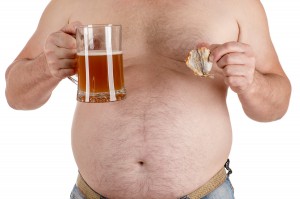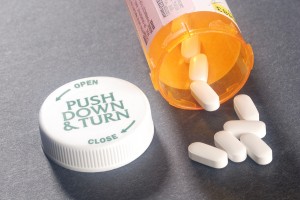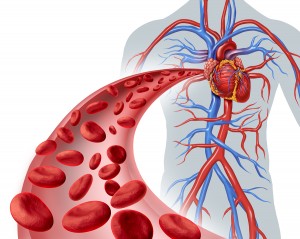You heard the expression “beer belly”, but now we learn “beer belly bad news”. It is an unflattering term for increased abdominal girth, especially in males. It is quite often that this picture is found in middle-aged men who consume more beer than what is good for them, but they may also mill around the hot dog stands at the ball game instead of being physically active. Any leftover calories are stored as belly fat, which protrudes their stomach as if they were pregnant.
There is a big difference between belly fat and body fat. Belly fat is metabolically much more active. Body fat is more sessile. So, it is the belly fat we need to do something about as this has been shown to be associated with heart attacks, strokes and diabetes.
Abdominal girth to hip ratio instead of BMI
Originally it was thought that excessive weight would best be measured with the body mass index (BMI). But subsequently it was shown that athletes with well-developed muscles could have BMI’s that were in the overweight (between 25.0 and 30.0) or even obese category (more than 30.0). Also, some people with heavy bones can have excessive BMI values despite them being normal based on other measurements. The new measurement is the old fashioned abdominal girth to hip ratio.
Weight gain leads to metabolic syndrome
You measure the abdominal girth, the hip girth and divide the abdominal girth by the hip girth. Normally this should be 80% (=0.8) or less for women and 90% (=0.9) or less for men. But a person with a beer belly will have ratios of 1.2 or 1.5.
If you take blood tests of that person you would also find elevated triglycerides, lowered HDL cholesterol (the protective cholesterol) and elevated LDL cholesterol (the bad cholesterol). In addition, we know from studies that often the insulin level is elevated in the sense of hyperinsulinism. In fact that person has often the metabolic syndrome, which is a characteristic change of the metabolism in an obese person. The blood is thicker with clotting factors floating around, there are inflammatory kinins that circulate and these factors work together on causing hardening of the arteries.
Why is a beer belly dangerous?
There are not only cardiovascular risk on the long-term causing heart attacks and strokes down the road. There is a danger of fat deposits in the liver, called fatty liver disease.
In time this can turn into liver cirrhosis and in some cases develop into liver cancer. Because belly fat causes inflammation in the system including in the lining of the blood vessels, this can in time also affect the immune system, weakening it and eventually allowing cancer to develop. Common cancers that are associated with obesity are breast cancer, ovarian cancer and uterine cancer in women, prostate cancer in men and pancreas and colon cancer in both sexes.
Estrogen from aromatase in beer bellies
In men beer bellies produce a lot of estrogen, the female hormone. This is so because fat tissue contains the enzyme aromatase that metabolizes male hormones into estrogen. Estrogen in men is only good in traces, but when the body produces it massively, it will counter testosterone production and will cause heart attacks and strokes.
What can you do about a beer belly?
We need to understand how beer bellies develop. One of the sources of fat from beer bellies is the consumption of foods that contain a lot of fructose. Food manufacturers have been diligent in mixing high fructose corn syrup into sugary drinks and into a myriad of processed foods.
Sugar itself can only be processed and stored until the glycogen stores in the liver and the muscles are filled. The liver metabolizes a surplus of sugar into triglycerides and LDL cholesterol. This is also the case for any fructose that comes from metabolized sucrose (table sugar) and from the high fructose corn syrup popular with the food processing industry. One problem is that fructose can only be processed by the liver, while glucose gets directly taken up by cells with the help of insulin.
German obesity wave after WWII in the 1960’s
The surplus of fructose metabolizes into triglycerides and LDL cholesterol before the body stores it as fat in fat cells. Unfortunately a lot of the fat will end up between your guts, in the liver as fatty liver and in the beer belly, a metabolically more active form of fat.
The sad part is that in the 1960’s I have seen the German economic wonder (“Wirtschaftswunder”) where many mid fifty to mid sixty business men died as a result of obesity and subsequent heart attacks and strokes. At that time Germans who were starving during World War II lived it up. This was in the late fifties and 1960’s. They ate whatever they could: cakes, fatty cheeses, whipped cream, fatty foods like pork roasts and beef.
Unhealthy hydrogenated fats, starchy food and sugar caused beer bellies
They also consumed loads of bread, buns, pasta and sugar. Margarine also became popular with its hydrogenated fatty acids that also contained free radicals. The end result was that they gained weight, did not exercise and developed their beer bellies.
In the 1980’s the school of thought was that saturated fatty acids were responsible for heart attacks, strokes and obesity. A low fat/high carb diet became popular and continued to steadily increase. Sure, the hydrogenated fatty acids did not help and should be cut out. But the bigger problem was the consumption of high fructose corn syrup and over-consumption of high glycemic-index carbohydrates.
Steps of how to get rid of the beer belly
Here is the solution of what to do get rid of the beer belly.
Eliminate sugar and high fructose from diet
Remove sugar and high fructose corn syrup from your diet.
Remove empty starches from your diet
The second effective step is to cut out as many empty starches that you can cut out like white rice, bread, sweets, cookies, cakes, ice cream and pasta. Starchy foods metabolize in the gut into sugar, which causes an insulin response. The extra insulin is responsible for developing inflammation in the arteries, which eventually leads to heart attacks and strokes.
Regular exercise
Exercise on a regular basis. This will produce HDL cholesterol, the protective cholesterol, which balances LDL cholesterol.
Rebalance your food intake
Perhaps the most important step is to rebalance your food intake. With this I mean that you replace high glycemic-index carbs with low glycemic-index carbs. This means you will eat a lot of salads, steamed vegetables, and fruit. This gives you a lot of extra fiber, which your system needs to slow down the rate of sugar absorption. It also helps you to lower LDL cholesterol and detoxify your body in the gut where fiber binds toxins.
Moderate your alcohol intake
If you are heavily into alcoholic drinks, this is another source of refined carbohydrates. They metabolize into LDL cholesterol, triglycerides and can cause fatty liver disease and liver cirrhosis. A moderate consumption of alcohol (one drink for women per day and two drinks for men per day) lowers the risk of heart attacks and strokes, while excessive alcohol intake increases the risk.
Bioidentical hormone replacement
Bioidentical hormone replacement may be something you have not heard about. But if you are a woman above the age of 40 or a man above the age of 50 chances are that you need some hormone tests. As a male, your natural hormone production from your testicles or adrenal glands is likely not keeping up. As a woman, your ovaries or adrenal glands are no longer keeping up with the demand of regular life. Part of the aging process is that the production of our sex hormones slows down. It does so shortly before menopause in women and shortly before andropause in men.
Lack of function of key organs in menopause and andropause
This will not only manifest itself in hot flashes and sleep disturbance in women. Men experience erectile dysfunction and grumpiness. Eventually this leads to a lack of energy production in the heart, the brain and other organ systems. When these organs have sex hormone receptors, but circulating sex hormones are missing, they cannot function optimally.
Lack of hormones causes heart attacks, strokes and cancer
A lack of hormones translates into yet another cause of heart attacks, strokes and certain cancers. This is an area where conventional medicine disagrees with anti-aging medicine. Years in general practice have taught me that heart attacks, strokes, colorectal cancer and pancreatic cancer happen more often when hormones are missing in both sexes. Cancer of the breasts, uterus and ovaries and prostate cancer are more common when sex hormones are missing. These cancers occur when natural sex hormone production declined.
On the other hand, with bioidentical hormone replacement the metabolism of all cells will return to normal. With this the likelihood of not developing all these illnesses at an earlier time is diminishing as well. It is not a panacea for eternal life, but it will add significant longevity. And with this comes the knowledge that you will not get premature disabilities, which is what we all need.
Conclusion
We need to assess our food intake habits and cut out the items that contribute to the beer belly. Next we need to ask ourselves what other change in lifestyle we require. Think about anything to improve our body shape and our energy metabolism. Life is too precious to just throw away years of fruitful living in our golden retirement years. Work on these factors in midlife or even in younger years and you will enjoy disease-free aging.















